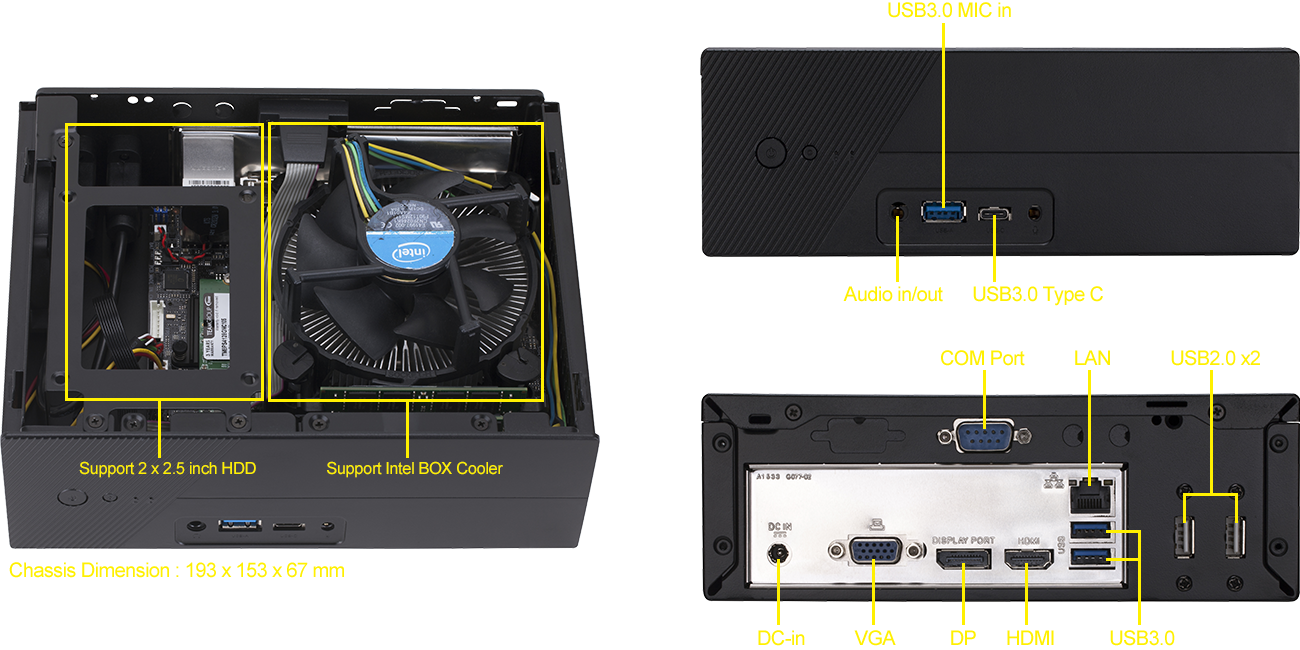GA-H310MSTX-HD3-CM (rev. 1.0)
* Product may vary based on local distribution.
* Self Assembly Required
- Supports 9th and 8th Generation Intel® Core™ Processors
- Dual Channel DDR4 SO-DIMM, 2 DIMMs
- Features USB 3.0 with USB Type-C™ Support
- 1 x RS232 COM Port Support
- M.2 Socket 1 Interface for WIFI+BT Module Support
- M.2 Socket 3 Interface for SATA/PCIe Mode SSD support
- Support 2 x 2.5 inch SATA3 HDD
- Rear Panel DisplayPort, HDMI 1.4, D-Sub Ports for Multi-Display Connection
- Intel® GbE LAN for WOL and PXE Support
- GIGABYTE UEFI DualBIOS™ Technology
- 193 mm(L) x 153 mm(W) x 67 mm(H) Chassis with 12~19V DC-In Power Design
- Support Intel® Small Business Basics * Wireless module inclusion may vary based on local distribution.
* Self Assembly Required
-
Mini STX System overview

-
 GIGABYTE Ultra Durable ™ Motherboards
GIGABYTE Ultra Durable ™ Motherboards
GIGABYTE 300 series motherboards support the latest 8th Generation Intel® Core™ processors, a 14nm desktop CPU which features improved performance, power efficiency and support for DDR4 memory, bringing cutting edge features and ultimate performance to your next PC build. -
 Connecting the Future - USB Type-C™:The World's Next Universal Connector
Connecting the Future - USB Type-C™:The World's Next Universal Connector
 The USB Type-C™ port with USB 3.0 support is a robust and slim connector for all of your devices with reversible plug orientation.
The USB Type-C™ port with USB 3.0 support is a robust and slim connector for all of your devices with reversible plug orientation.
-
 Dual M.2 Technology for SSD Drive and WIFI CardFast Data Transfer and Advanced WIFI NetworkingGIGABYTE H310MSTX-HD3 motherboard features Dual M.2 technology which for SATA/PCIe mode SSD devices connectivity and also for 11ac WIFI & Bluetooth 4.0 card usage. GIGABYTE’s stacked design optimizes the PCB real-estate usage, allowing more components to be efficiently added without compromising any space.
Dual M.2 Technology for SSD Drive and WIFI CardFast Data Transfer and Advanced WIFI NetworkingGIGABYTE H310MSTX-HD3 motherboard features Dual M.2 technology which for SATA/PCIe mode SSD devices connectivity and also for 11ac WIFI & Bluetooth 4.0 card usage. GIGABYTE’s stacked design optimizes the PCB real-estate usage, allowing more components to be efficiently added without compromising any space. -
 Enjoy true HD display capability using the most commonly integrated digital output technologies on today’s HD displays and TVs.
Enjoy true HD display capability using the most commonly integrated digital output technologies on today’s HD displays and TVs.
High Definition Digital Outputs
 * Support for up to 2 displays at the same time.
* Support for up to 2 displays at the same time.
-
4K Ultra HD Support
 4K resolution is the next technological milestone in high-definition content delivery, utilizing approximately 4,000 pixels on the horizontal axis, more than four times today's standard HD pixel density. GIGABYTE motherboards provide native 4K support with integrated Intel® HD Graphics via HDMI.
4K resolution is the next technological milestone in high-definition content delivery, utilizing approximately 4,000 pixels on the horizontal axis, more than four times today's standard HD pixel density. GIGABYTE motherboards provide native 4K support with integrated Intel® HD Graphics via HDMI.

-
HDMI™-The Next Generation Multimedia Interface
 HDMI™ is a High-Definition Multimedia Interface which provides up to 5Gb/s video transmitting bandwidth and 8-channel high quality audio all through a single cable. Able to transmit superior, uncompressed digital video and audio, HDMI™ ensures the crispest rendering of digital content up to 1080p without the quality losses associated with analog interfaces and their digital-to-analog conversion. In addition, HDMI™ is compatible with HDCP (High-bandwidth Digital Content Protection), allowing the playback of Blu-ray/HD DVD and other protected media content.
HDMI™ is a High-Definition Multimedia Interface which provides up to 5Gb/s video transmitting bandwidth and 8-channel high quality audio all through a single cable. Able to transmit superior, uncompressed digital video and audio, HDMI™ ensures the crispest rendering of digital content up to 1080p without the quality losses associated with analog interfaces and their digital-to-analog conversion. In addition, HDMI™ is compatible with HDCP (High-bandwidth Digital Content Protection), allowing the playback of Blu-ray/HD DVD and other protected media content.
-
Display Port Support
 Selected GIGABYTE motherboards feature DisplayPort, a next generation graphics display interface that delivers up to 10.8 Gbps of bandwidth over standard cables, providing billions of colors with the fastest refresh rates and the greatest color depths.
Selected GIGABYTE motherboards feature DisplayPort, a next generation graphics display interface that delivers up to 10.8 Gbps of bandwidth over standard cables, providing billions of colors with the fastest refresh rates and the greatest color depths. -
 Intel® GbE LAN with WOL and PXE Support
Intel® GbE LAN with WOL and PXE Support
Intel® Gigabit LAN with WOL and PXE support, deliver better network responsiveness and conveniently user experience in crowded LAN environments, to offer hassle free and high speed network connectivity. -
-
Mini STX System VESA and Foot Stand


* I termini HDMI, Interfaccia multimediale ad alta definizione HDMI (HDMI High- Definition Multimedia Interface), immagine commerciale HDMI (HDMI Trade dress) e i loghi HDMI sono marchi commerciali o marchi commerciali registrati di HDMI Licensing Administrator, Inc.
* I materiali qui forniti sono solo di riferimento. GIGABYTE si riserva il diritto di modificare o rivedere il contenuto in qualsiasi momento senza preavviso.
* Le prestazioni pubblicate si basano su valori massimi teorici fornite dai rispettivi fornitori di chipset o organizzazione che hanno definito le specifiche di interfaccia. Le prestazioni effettive possono variare in base alla configurazione del sistema.
* Tutti i marchi ei loghi sono di proprietà dei rispettivi titolari.
* A causa dell'architettura standard del PC, una certa quantità di memoria è riservata al sistema e quindi la capacità di memoria reale è inferiore a quella dichiarata.























